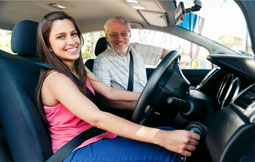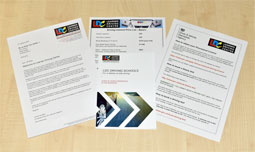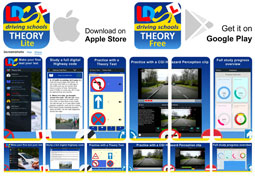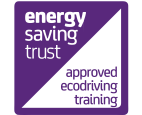Driving lesson 11. Hazard perception & defensive driving
Introduction
You will recall from Lesson 6 that a hazard may be defined as anything that might cause you to change speed, position or direction. Hazards can be caused by static road features (e.g. junctions, speed humps, extended causeway etc.) or by the actions of other road users or a combination of the two. This driving lesson concentrates on the hazards that develop through the actions of other road users and those circumstances that can contribute to their hazardous behaviour.
Key learning notes
Hazard Perception
Hazard perception in driving terms can be defined as: 'The art of being able to pick out the important details from all the information provided by your senses.' A perceptive driver must look for clues and build up a mental picture of what they think might happen next in order to anticipate the actions of other road users and to determine any risks.
While hazard perception skills can only truly be acquired through experience (preferably under the guidance of a professional driving instructor) you can speed up the learning process by having a better understanding of the factors that an expert driver considers when building up this mental picture of what is likely to happen next.
 Road signs
Road signs
Road signs can provide you with a clear warning of what lies ahead. It is essential that you train yourself to take note of all road signs and act accordingly.
Location
Are you in a busy town centre or on a country road? It would be unlikely that you would meet a flock of sheep in the high street, but there may be one just around the corner on a country road. Whatever your location you must always consider the type of hazard that you might expect to meet there, and be driving at such a speed that you can stop safely, if necessary.
 Time of day
Time of day
The time of day can give you a lot of information about what to expect on the road. Children can be present in the road at any time, but they are out in force just before and after school. Therefore, you should be keeping a special look out for children during the morning rush hour and mid-afternoon periods.
Other road users
It may seem fairly obvious that you should look out for other road users, but remember you are not just looking for them, you are looking for clues about what they will do next.
Pedestrians - The Highway Code explains that those pedestrians most at risk on the road are over 60 and less than 15. Old people do not judge speed and distance very well and their reactions can be slow. Some of the questions you should ask yourself are: Have they seen me? Can they hear me? Are they looking my way?
Children have little time to consider road safety; they are more interested in the game they are playing or the ice cream van they are running after.
Look for clues. Are they alone? If one child runs or cycles into the road there will often be at least one more following; footballs are followed by children; bicycles, seemingly abandoned at the side of the road will mean that children are not far away.
All pedestrians, not just the young and old, are at risk on the road. If there are pedestrians about, make sure that you know what they are going to do before they do it.
 Animals - Noise and vehicles frighten animals. Therefore, drive slowly, don't sound your horn or rev up the engine and keep your distance. Watch their behaviour carefully, particularly if it is a horse ridden by a child.
Animals - Noise and vehicles frighten animals. Therefore, drive slowly, don't sound your horn or rev up the engine and keep your distance. Watch their behaviour carefully, particularly if it is a horse ridden by a child.
![]() Cyclists - Drivers should have more control over their vehicles than cyclists who are dependent upon physical strength and effort to pilot their machines. Always leave plenty of room when passing cyclists look out for clues about their next move. For example, a cyclist who looks around over his right shoulder may be about to turn right; a puddle in the road will cause a cyclist to move out. Cyclists are not easy to see and they can easily get lost in the blind spots around your vehicle. Particularly watch out for them in slow moving traffic in built up areas - they may overtake you on either side when you least expect it.
Cyclists - Drivers should have more control over their vehicles than cyclists who are dependent upon physical strength and effort to pilot their machines. Always leave plenty of room when passing cyclists look out for clues about their next move. For example, a cyclist who looks around over his right shoulder may be about to turn right; a puddle in the road will cause a cyclist to move out. Cyclists are not easy to see and they can easily get lost in the blind spots around your vehicle. Particularly watch out for them in slow moving traffic in built up areas - they may overtake you on either side when you least expect it.
Motorcyclists - Like cyclists, motorcyclists are not easy to see particularly at dusk and at night. Like cyclists they may also take up unusual road positions to avoid holes and bumps in the road surface. It is very easy to miss an approaching motorcyclist when emerging at junctions so remember: Think once, think twice, think bike!
Drivers - If you are unsure about what a driver is going to do next, leave plenty of space between you and them. A sporty looking car may be driven by someone more interested in 'posing' than driving. Look out for the actions of drivers; a driver who has just stopped may open his door without checking to see if it is safe; a driver who seems to be dithering about may be a stranger to the area and could therefore make a last minute turn without a signal when he sees the road he is looking for.
Large vehicles - Buses and large vehicles need more room and may take up an unusual road position to turn round corners at junctions etc. Hold back and give them plenty of room.
Inconsistent behaviour
Inconsistent behaviour is often a very good clue to what might happen next. Just because a bus is signalling left prior to the side road that you intend to emerge from doesn't mean that you should go on the assumption that the bus is turning left? Look to see if all the actions of the driver are consistent with the signal. Is the vehicle slowing down as you would expect to complete the proposed turn?

Is the position of the vehicle consistent with the proposed manoeuvre? Is the driver looking in the direction they wish to turn? Could the driver be signalling left for any other reason? In this example the bus driver may be signalling left to pull up at a bus stop just after the side road. Make sure you look at all the evidence before you finally decide.
Let's consider another example. If you were driving behind a vehicle indicating to turn left but the road on the left had a no entry sign at its entrance it is quite probable that the driver will stop suddenly or swerve away at the last minute once he or she realises the mistake. Therefore anything that would potentially prevent the driver from completing the proposed manoeuvre safely would make the proposed action inconsistent.
Train your mind to recognise inconsistency - if a situation is not quite right, ask yourself, why is that?
What other drivers cannot see
Consider what you can see that other drivers cannot see. This may play an important part in determining what may happen next. As well as determining whether the drivers behaviour is consistent with the manoeuvre they propose to complete also consider whether you can see something or someone that they cannot see that may cause them to alter their course or abort the manoeuvre at the last minute. Also consider whether other drivers need to see you and if so determine what you can do to make your presence known to them.
The weather and visibility
Bright sunlight, fog, rain and snow can severely affect visibility so slow down and give yourself more space. At dusk and at night the driver loses the ability to see any detail and dark objects easily merge into the background. Consider not only how this will affect your judgement but also how the conditions might affect other drivers.
Is the other driver being blinded by bright sunlight or if at night by headlights on full beam?
Are the windows of the other vehicle misty - can the driver see you?
Will the high sided vehicle, in high wind, remain stable when it crosses a gap in the hedge or buildings that line the side of the road?
Also remember the effects of water, ice and snow on the road surface - are the other drivers driving too fast for the weather conditions - are you driving too fast for these conditions?
Defensive driving
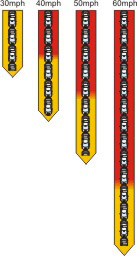 Driving defensively is all about giving yourself time to react and keeping your options open. Even someone with lightening fast reactions needs time to react. The chart below shows the distance it takes to stop a car when travelling at 30mph or above assuming you could instantly apply the brakes (i.e. no thinking time). Most people take at least two thirds of a second to apply the brakes which means you need to add an extra two car lengths at 30mph and 6 car lengths at 60mph to those shown. If anything or anyone is within the distances shown they will be hit. You could call this area 'The Impact Zone', however if you are travelling at 40mph or more it might be more appropriate to call it 'The Killing Zone', as anyone hit at 40 mph or more is unlikely to survive.
Driving defensively is all about giving yourself time to react and keeping your options open. Even someone with lightening fast reactions needs time to react. The chart below shows the distance it takes to stop a car when travelling at 30mph or above assuming you could instantly apply the brakes (i.e. no thinking time). Most people take at least two thirds of a second to apply the brakes which means you need to add an extra two car lengths at 30mph and 6 car lengths at 60mph to those shown. If anything or anyone is within the distances shown they will be hit. You could call this area 'The Impact Zone', however if you are travelling at 40mph or more it might be more appropriate to call it 'The Killing Zone', as anyone hit at 40 mph or more is unlikely to survive.
Due to this it is important to anticipate what might happen and act upon it, rather than waiting for it to happen. To do this effectively you need to:
- Look well ahead and perceive potential problems early.
- Apply your hazard drill in good time.
- Give yourself plenty of space.
Look well ahead and perceive potential problems early
See and be seen. Take up a safe road position that allows you to see and be seen. Be attentive; focus on the driving task - don't let your mind wander.
Keep your eyes moving and scan the road well ahead. Avoid staring at any single point ahead or to the side. Concentrate on the available space (i.e. the gaps), not the obstructions.
With experience and guidance from your instructor you will begin to recognise what feedback from your senses is important and what is not. Ignore the superficial information you can see. For example don't concentrate on identifying individual drivers or pedestrians or the make, model and colour of vehicles. Instead concentrate on the position, speed and potential course of other vehicles and pedestrians to the front, rear and sides of your vehicle.
Look as far down the road as you can
see for any potential hazards whether they are static road features or situations being caused by other road users. A gap in the tree line ahead may mean that there is a side road at that point or an upside down triangle sign in the distance may warn you that you are approaching a T junction.
Apply the Hazard Drill in good time
As soon as you perceive a potential danger, begin to use your Hazard Drill and determine where you can go or how you can stop if the danger materialises. Remember you need to consider what's behind as well as what is in front when considering your options.
Give yourself plenty of space
You need to give yourself the time to recognise a potential problem and apply the Hazard Drill. We refer to this as 'Driving in space'. Maintain a buffer of space or a safety bubble around you at all times. The higher your speed the bigger the bubble needs to be.
![]()
Space to the front - you must allow yourself enough room to stop. So always travel at a speed that allows you to stop well within the distance you can see to be clear.
Space to the sides - make sure that you leave enough room for pedestrians, cyclists, motorcyclists and other vehicles. If you are unsure whether or not you will fit through a gap, you won't! Give parked cars and pedestrians at the side of the road plenty of clearance. Remember pedestrians are far more vulnerable then vehicles. Allow for car doors opening, children appearing from between parked cars or pedestrians
wandering onto the road particularly in crowded streets. Position your car accordingly and reduce speed as the space to the sides of your vehicle is reduced.
Space to the rear - try to keep a minimum safety gap of two seconds between your vehicle and the one in front. If another vehicle is following too closely gradually ease off the accelerator and slow down in order to increase the gap in front of you.

![]()
Highway Code study
Rules: 91, 93 - 96, 124, 125, 144 - 152, 204 - 225, 226 - 237.

